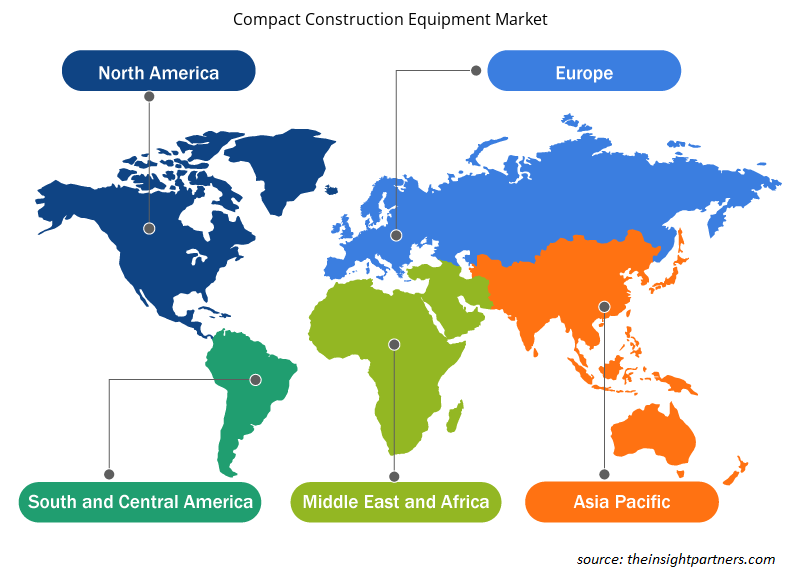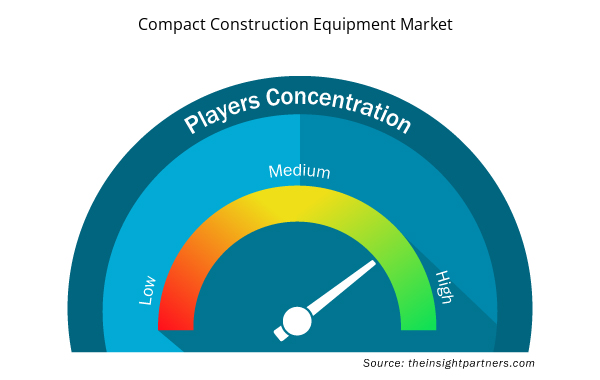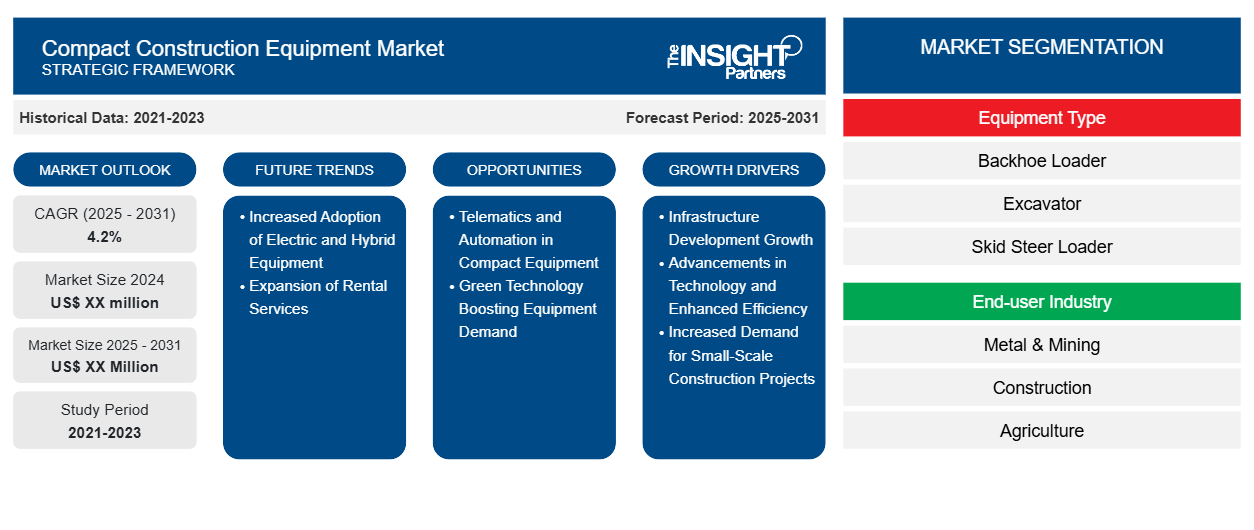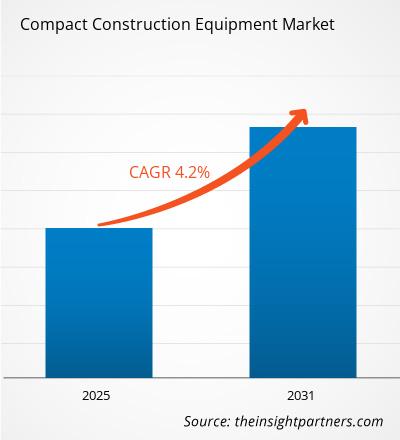Le marché des équipements de construction compacts devrait enregistrer un TCAC de 4,2 % de 2023 à 2031, avec une taille de marché passant de XX millions USD en 2023 à XX millions USD d'ici 2031.
Le marché est segmenté en équipement, utilisateur final et application. Le segment équipement est divisé en chargeuse-pelleteuse, excavatrice, chargeuse compacte, chariot télescopique, chargeuse sur chenilles et autres. En fonction de l'utilisateur final, le marché est segmenté en métallurgie et exploitation minière, construction, agriculture et autres. En fonction de l'application, le marché est divisé en chargement, excavation, manutention, levage et hissage et autres
Objectif du rapport
Le rapport sur le marché des équipements de construction compacts de The Insight Partners vise à décrire le paysage actuel et la croissance future, les principaux facteurs moteurs, les défis et les opportunités. Cela fournira des informations à diverses parties prenantes commerciales, telles que :
- Fournisseurs/fabricants de technologie : pour comprendre l’évolution de la dynamique du marché et connaître les opportunités de croissance potentielles, leur permettant de prendre des décisions stratégiques éclairées.
- Investisseurs : Effectuer une analyse complète des tendances concernant le taux de croissance du marché, les projections financières du marché et les opportunités qui existent tout au long de la chaîne de valeur.
- Organismes de réglementation : Réglementer les politiques et surveiller les activités du marché dans le but de minimiser les abus, de préserver la confiance des investisseurs et de maintenir l’intégrité et la stabilité du marché.
Segmentation du marché des équipements de construction compacts
Type d'équipement
- Chargeuse-pelleteuse
- Excavateur
- Chargeuse compacte
- Chariot télescopique
- Chargeuse sur chenilles
- Autres
Secteur d'utilisation finale
- Métallurgie et mines
- Construction
- Agriculture
- Autres
Application
- Chargement
- Excavation
- Manutention de matériaux
- Levage et hissage
- Autres
Géographie
- Amérique du Nord
- Europe
- Asie-Pacifique
- Amérique du Sud et Amérique centrale
- Moyen-Orient et Afrique
Géographie
- Amérique du Nord
- Europe
- Asie-Pacifique
- Amérique du Sud et Amérique centrale
- Moyen-Orient et Afrique
Personnalisez ce rapport en fonction de vos besoins
Vous bénéficierez d'une personnalisation gratuite de n'importe quel rapport, y compris de certaines parties de ce rapport, d'une analyse au niveau des pays, d'un pack de données Excel, ainsi que d'offres et de remises exceptionnelles pour les start-ups et les universités.
- Obtenez les principales tendances clés du marché de ce rapport.Cet échantillon GRATUIT comprendra une analyse de données, allant des tendances du marché aux estimations et prévisions.
Facteurs de croissance du marché des équipements de construction compacts
- Croissance du développement des infrastructures : L'augmentation des niveaux d'investissement dans les projets d'infrastructures à travers le monde est devenue l'un des principaux moteurs du marché des équipements de construction compacts. Les gouvernements et le secteur privé investissent massivement dans la construction de routes, de ponts et de développements urbains, ce qui accroît la demande de machines compactes capables de fonctionner en grand nombre dans des espaces limités.
- Progrès technologiques et efficacité accrue : les améliorations technologiques apportées aux équipements de construction compacts, notamment en termes d'efficacité énergétique, d'amélioration des performances et d'intégration télématique, alimentent la croissance du marché. De telles innovations contribuent également à réduire les coûts d'exploitation en améliorant la productivité et en améliorant la gestion des équipements. Par conséquent, les machines de construction compactes restent très attractives pour les entrepreneurs et les sociétés de location.
- Augmentation de la demande pour les projets de construction à petite échelle : ce type d'équipement est de plus en plus demandé en raison de la multiplication des projets de construction à petite échelle tels que les projets résidentiels, d'aménagement paysager et d'infrastructures gouvernementales locales. En effet, les équipements de construction compacts sont très productifs mais moins exigeants en termes d'espace de travail et de nombre réduit de travailleurs. Ils peuvent effectuer diverses opérations telles que le creusement, le nivellement et le levage, entre autres.
Tendances futures du marché des équipements de construction compacts
- Adoption croissante d'équipements électriques et hybrides : L'introduction d'équipements de construction compacts électriques et hybrides est devenue très en vogue. En effet, ces machines permettent de réduire considérablement les émissions ainsi que les coûts d'exploitation pour les utilisateurs, en plus des pressions réglementaires de plus en plus fortes en faveur du respect de l'environnement dans le domaine de la construction.
- Expansion des services de location : La tendance à louer plutôt qu'acheter des équipements de construction gagne du terrain. La plupart des entrepreneurs préfèrent louer des équipements de construction compacts pour éviter les dépenses d'investissement et réduire la maintenance de l'équipement, ce qui nécessite un marché de location plus vaste pour répondre à cette demande en machines compactes.
Opportunités de marché pour les équipements de construction compacts
- Télématique et automatisation dans les équipements compacts : La télématique et l'automatisation, entre autres technologies de pointe, ouvrent de grandes perspectives aux équipements de construction compacts. La télématique peut contribuer de manière significative à accroître l'efficacité opérationnelle, à améliorer la sécurité et à analyser les données en temps réel, ce qui rend ces équipements compacts encore plus attrayants pour les entrepreneurs et les entreprises de construction.
- La technologie verte stimule la demande d'équipements : l'industrie de la construction accordant une plus grande importance à la durabilité, les équipements de construction compacts intégrant la technologie verte sont voués à trouver davantage de débouchés. Les équipements à faibles émissions et économes en carburant peuvent attirer les clients soucieux de l'environnement et seront plus en phase avec les exigences réglementaires plus strictes
Aperçu régional du marché des équipements de construction compacts
Les tendances et facteurs régionaux influençant le marché des équipements de construction compacts tout au long de la période de prévision ont été expliqués en détail par les analystes d’Insight Partners. Cette section traite également des segments et de la géographie du marché des équipements de construction compacts en Amérique du Nord, en Europe, en Asie-Pacifique, au Moyen-Orient et en Afrique, ainsi qu’en Amérique du Sud et en Amérique centrale.

- Obtenez les données régionales spécifiques au marché des équipements de construction compacts
Portée du rapport sur le marché des équipements de construction compacts
| Attribut de rapport | Détails |
|---|---|
| Taille du marché en 2023 | XX millions de dollars américains |
| Taille du marché d'ici 2031 | XX millions de dollars américains |
| Taux de croissance annuel composé mondial (2023-2031) | 4,2% |
| Données historiques | 2021-2022 |
| Période de prévision | 2024-2031 |
| Segments couverts | Par type d'équipement
|
| Régions et pays couverts | Amérique du Nord
|
| Leaders du marché et profils d'entreprises clés |
|
Densité des acteurs du marché des équipements de construction compacts : comprendre son impact sur la dynamique commerciale
Le marché des équipements de construction compacts connaît une croissance rapide, tirée par la demande croissante des utilisateurs finaux en raison de facteurs tels que l'évolution des préférences des consommateurs, les avancées technologiques et une plus grande sensibilisation aux avantages du produit. À mesure que la demande augmente, les entreprises élargissent leurs offres, innovent pour répondre aux besoins des consommateurs et capitalisent sur les tendances émergentes, ce qui alimente davantage la croissance du marché.
La densité des acteurs du marché fait référence à la répartition des entreprises ou des sociétés opérant sur un marché ou un secteur particulier. Elle indique le nombre de concurrents (acteurs du marché) présents sur un marché donné par rapport à sa taille ou à sa valeur marchande totale.
Les principales entreprises opérant sur le marché des équipements de construction compacts sont :
- Caterpillar, Inc.
- AB Volvo
- Deere & Company
- Hyundai Heavy Industries Co. Ltd
- Groupe XCMG
Avis de non-responsabilité : les sociétés répertoriées ci-dessus ne sont pas classées dans un ordre particulier.

- Obtenez un aperçu des principaux acteurs du marché des équipements de construction compacts
Principaux arguments de vente
- Couverture complète : Le rapport couvre de manière exhaustive l’analyse des produits, des services, des types et des utilisateurs finaux du marché des équipements de construction compacts, offrant un paysage holistique.
- Analyse d’experts : Le rapport est compilé sur la base d’une compréhension approfondie des experts et analystes du secteur.
- Informations à jour : Le rapport garantit la pertinence commerciale en raison de sa couverture des informations récentes et des tendances des données.
- Options de personnalisation : ce rapport peut être personnalisé pour répondre aux exigences spécifiques du client et s'adapter parfaitement aux stratégies commerciales.
Le rapport de recherche sur le marché des équipements de construction compacts peut donc aider à ouvrir la voie au décodage et à la compréhension du scénario de l’industrie et des perspectives de croissance. Bien qu’il puisse y avoir quelques préoccupations valables, les avantages globaux de ce rapport ont tendance à l’emporter sur les inconvénients.
- Analyse historique (2 ans), année de base, prévision (7 ans) avec TCAC
- Analyse PEST et SWO
- Taille du marché Valeur / Volume - Mondial, Régional, Pays
- Industrie et paysage concurrentiel
- Ensemble de données Excel



Report Coverage
Revenue forecast, Company Analysis, Industry landscape, Growth factors, and Trends

Segment Covered
This text is related
to segments covered.

Regional Scope
North America, Europe, Asia Pacific, Middle East & Africa, South & Central America

Country Scope
This text is related
to country scope.
Questions fréquemment posées
The leading players includes Caterpillar, Inc., AB Volvo, Deere & Company, Hyundai Heavy Industries Co. Ltd, XCMG Group, J C Bamford Excavators Ltd., Komatsu Ltd, Manitou BF, Hyster-Yale Group, Inc.., and Sany Group
The report can be delivered in PDF/PPT format; we can also share excel dataset based on the request.
Some of the customization options available based on the request are an additional 3-5 company profiles and country-specific analysis of 3-5 countries of your choice. Customizations are to be requested/discussed before making final order confirmation, as our team would review the same and check the feasibility.
The Compact Construction Equipment Market Size and Forecasts (2021 - 2031), Global and Regional Share, Trends, and Growth Opportunity Analysis Report Coverage:by Equipment Type (Backhoe Loader, Excavator, Skid Steer Loader, Telehandler, Track Loader, and Others), End-user Industry (Metal & Mining, Construction, Agriculture, and Others), and Application (Loading, Excavation, Material Handling, Lifting & Hoisting, and Others), and Geography (North America, Europe, Asia Pacific, and South and Central America) is estimated to witness a CAGR of 4.2% from 2023 to 2031
The major factors driving the Compact Construction Equipment market are: Infrastructure Development Growth
Trends and growth analysis reports related to Manufacturing and Construction : READ MORE..
1. Caterpillar, Inc.
2. AB Volvo
3. Deere & Company
4. Hyundai Heavy Industries Co. Ltd
5. XCMG Group
6. J C Bamford Excavators Ltd.
7. King Machinery
8. Komatsu,.Ltd
9. Manitou BF, S.A. (Mustang)
10. SANY Group
The Insight Partners performs research in 4 major stages: Data Collection & Secondary Research, Primary Research, Data Analysis and Data Triangulation & Final Review.
- Data Collection and Secondary Research:
As a market research and consulting firm operating from a decade, we have published and advised several client across the globe. First step for any study will start with an assessment of currently available data and insights from existing reports. Further, historical and current market information is collected from Investor Presentations, Annual Reports, SEC Filings, etc., and other information related to company’s performance and market positioning are gathered from Paid Databases (Factiva, Hoovers, and Reuters) and various other publications available in public domain.
Several associations trade associates, technical forums, institutes, societies and organization are accessed to gain technical as well as market related insights through their publications such as research papers, blogs and press releases related to the studies are referred to get cues about the market. Further, white papers, journals, magazines, and other news articles published in last 3 years are scrutinized and analyzed to understand the current market trends.
- Primary Research:
The primarily interview analysis comprise of data obtained from industry participants interview and answers to survey questions gathered by in-house primary team.
For primary research, interviews are conducted with industry experts/CEOs/Marketing Managers/VPs/Subject Matter Experts from both demand and supply side to get a 360-degree view of the market. The primary team conducts several interviews based on the complexity of the markets to understand the various market trends and dynamics which makes research more credible and precise.
A typical research interview fulfils the following functions:
- Provides first-hand information on the market size, market trends, growth trends, competitive landscape, and outlook
- Validates and strengthens in-house secondary research findings
- Develops the analysis team’s expertise and market understanding
Primary research involves email interactions and telephone interviews for each market, category, segment, and sub-segment across geographies. The participants who typically take part in such a process include, but are not limited to:
- Industry participants: VPs, business development managers, market intelligence managers and national sales managers
- Outside experts: Valuation experts, research analysts and key opinion leaders specializing in the electronics and semiconductor industry.
Below is the breakup of our primary respondents by company, designation, and region:

Once we receive the confirmation from primary research sources or primary respondents, we finalize the base year market estimation and forecast the data as per the macroeconomic and microeconomic factors assessed during data collection.
- Data Analysis:
Once data is validated through both secondary as well as primary respondents, we finalize the market estimations by hypothesis formulation and factor analysis at regional and country level.
- Macro-Economic Factor Analysis:
We analyse macroeconomic indicators such the gross domestic product (GDP), increase in the demand for goods and services across industries, technological advancement, regional economic growth, governmental policies, the influence of COVID-19, PEST analysis, and other aspects. This analysis aids in setting benchmarks for various nations/regions and approximating market splits. Additionally, the general trend of the aforementioned components aid in determining the market's development possibilities.
- Country Level Data:
Various factors that are especially aligned to the country are taken into account to determine the market size for a certain area and country, including the presence of vendors, such as headquarters and offices, the country's GDP, demand patterns, and industry growth. To comprehend the market dynamics for the nation, a number of growth variables, inhibitors, application areas, and current market trends are researched. The aforementioned elements aid in determining the country's overall market's growth potential.
- Company Profile:
The “Table of Contents” is formulated by listing and analyzing more than 25 - 30 companies operating in the market ecosystem across geographies. However, we profile only 10 companies as a standard practice in our syndicate reports. These 10 companies comprise leading, emerging, and regional players. Nonetheless, our analysis is not restricted to the 10 listed companies, we also analyze other companies present in the market to develop a holistic view and understand the prevailing trends. The “Company Profiles” section in the report covers key facts, business description, products & services, financial information, SWOT analysis, and key developments. The financial information presented is extracted from the annual reports and official documents of the publicly listed companies. Upon collecting the information for the sections of respective companies, we verify them via various primary sources and then compile the data in respective company profiles. The company level information helps us in deriving the base number as well as in forecasting the market size.
- Developing Base Number:
Aggregation of sales statistics (2020-2022) and macro-economic factor, and other secondary and primary research insights are utilized to arrive at base number and related market shares for 2022. The data gaps are identified in this step and relevant market data is analyzed, collected from paid primary interviews or databases. On finalizing the base year market size, forecasts are developed on the basis of macro-economic, industry and market growth factors and company level analysis.
- Data Triangulation and Final Review:
The market findings and base year market size calculations are validated from supply as well as demand side. Demand side validations are based on macro-economic factor analysis and benchmarks for respective regions and countries. In case of supply side validations, revenues of major companies are estimated (in case not available) based on industry benchmark, approximate number of employees, product portfolio, and primary interviews revenues are gathered. Further revenue from target product/service segment is assessed to avoid overshooting of market statistics. In case of heavy deviations between supply and demand side values, all thes steps are repeated to achieve synchronization.
We follow an iterative model, wherein we share our research findings with Subject Matter Experts (SME’s) and Key Opinion Leaders (KOLs) until consensus view of the market is not formulated – this model negates any drastic deviation in the opinions of experts. Only validated and universally acceptable research findings are quoted in our reports.
We have important check points that we use to validate our research findings – which we call – data triangulation, where we validate the information, we generate from secondary sources with primary interviews and then we re-validate with our internal data bases and Subject matter experts. This comprehensive model enables us to deliver high quality, reliable data in shortest possible time.


 Obtenez un échantillon gratuit pour ce rapport
Obtenez un échantillon gratuit pour ce rapport